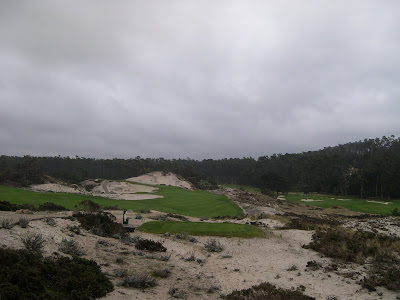While the term sustainability has different meaning to different people, a sustainable approach to golf course development begins through an “organic approach” to golf architecture.
It was legendary American building architect Frank Lloyd Wright (1867-1959) who coined the termed “organic architecture”. Wright emphasized harmony between architecture and the natural world through design approaches which are sympathetic and well-integrated with the environment.
Wright’s approach to building architecture easily applies to golf architecture. In fact, almost without exception, those courses consistently recognized as the world’s best were created by architects, like Wright, who also employ an organic approach to golf course design.
#9 Cypress Point Club at Monterey, California. Laid out by legendary golf architect Alister Mackenzie, the design of Cypress Point is extremely sympathetic and well-integrated with the environment.
These particular courses (think Pine Valley, Cypress Point, Royal Melbourne, Sand Hills, and Pacific Dunes at Bandon, Oregon for example) are extremely sympathetic and well-integrated with the environment. They possess a remarkably distinct relationship with nature, setting a fine example for golf course development into the future.
Indeed. The world’s best courses are laid-out to utilize inherent topography, natural drainage patterns, and indigenous plant life in a sincere effort to conserve nature. They celebrate the beauty and harmony of natural forms, flows and systems; and, in turn, present a distinct sense of place lending to their individual greatness.
Through utilization of existing site characteristics, an “organic approach” to golf architecture significantly minimizes required earthwork, area of maintained turf, and associated inputs, along with potential environmental impacts.
Dramatic #17 at Cypress Point Club at Monterey, California.
These days, too, golf architects and course superintendents are becoming increasingly innovative with regard to turf-grass selection. Cognizant of the fact that water is becoming more scarce and environmental legislation more stringent, modern golf course developments are more frequently featuring turf-grass varieties which require comparatively few inputs (most notably water, fertilizer and chemical applications).
In some cases, effluent has become a wonderful source for watering turf. In others, sophisticated drainage and irrigation systems designed to collect and channel water to be recycled and reused are becoming more prevalent, in a sincere attempt to make most efficient use of this increasingly precious resource.
Thankfully, heavy-handed golf course construction and lush, green swards of turf are no longer en vogue. Instead, an “organic approach” to golf architecture and course maintenance is once again mainstream. This is only in part due to modern environmental (and economic) realities, too. An “organic approach” to golf architecture and course maintenance is simply the sensible approach.
In turn, there are a legion of enterprising golf architects and course superintendents working throughout the world today who are consistently making sustainable choices relative to ecological and societal considerations, staunchly determined to meet the needs of today without sacrificing the future.


1 Comments so far
I think the best statement is that many people should realize that being environmentally responsible is becoming mainstream.
That is the take home message that we need to push at our green committee meetings. You ay be surprised at how some members want to be stewards of the environment and just as they brag about the green speeds with their buddies they also brag about being more aware of the environmental stewardship at their club.
We can only hope the new topic is not how fast the greens stimp, but who has the smallest carbon footprint??
EmoticonEmoticon